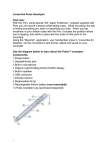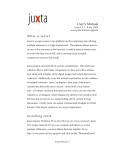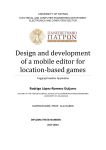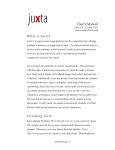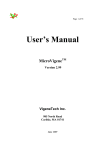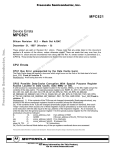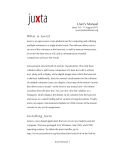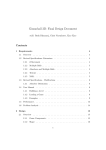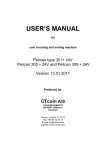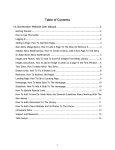Download Like Leaving the Nile. IVANHOE, a User`s Manual
Transcript
Literature Compass 2 (2005) VI 149, 1–27 Like Leaving the Nile. IVANHOE, a User’s Manual Jerome McGann University of Virginia How to Access IVANHOE [Readers of the following article are able to access a demo version of IVANHOE with the instructions below. The online medium of this article will thus enable you to observe the ideas expressed here as you read. Readers should go to the website for IVANHOE at the following URL: http://patacriticism.org/ivanhoe. The site supplies much general and specific information about IVANHOE that will be found useful. It also has a QuickTime demo introduction to how to use the software, as well as two demo games – one to track how a particular game was played, another to test out how to use the software yourself. Go to http://patacriticism.org/ivanhoe/wantToPlay.html to access a Java demo of IVANHOE. After clicking “Ivanhoe Demo” and reaching the login screen, enter an arbitrary Username and an arbitrary Password. In the window displaying “IVANHOE playspaces” you can then choose which of the two games you want to join: the “archived” demo of a game that was already played, or the “live” game that you can experiment with to “learn-by-doing”. Both are tied to Jerome K. Jerome’s late-nineteenthcentury story “Three Men in a Boat”. The loading process will take you through two steps: the “select a role” page and the “game information” page. Click the “continue” button at the lower right of each, and you will then be ushered into the gamespace. It may take a few seconds for the application to load, and your computer requires Java 1.4.2 or higher. The “live” game is configured so that after seven days the gameplay will be cleared and the gamespace refreshed for another set of testing moves.] Digital technology used by humanities scholars has focused almost exclusively on methods of sorting, accessing, and disseminating large bodies of materials, and on certain specialized problems in computational stylistics and linguistics. In this respect the work rarely engages those questions about interpretation and self-aware reflection that are the central concerns for most humanities scholars and educators. Digital technology has remained instrumental in serving the technical and pre-critical occupations of librarians and archivists and editors. But the general field of humanities education and scholarship will not take the use of © Blackwell Publishing 2005 2 IVANHOE, a User’s Manual digital technology seriously until one demonstrates how its tools improve the ways we explore and explain aesthetic works – until, that is, they expand our interpretational procedures. “Preface,” Radiant Textuality I Reflecting in 2001 on the recent development of Information Technology (IT) and the humanities, I wrote that somewhat grand pronunciamento. Reflecting again now I have to say, with Edward Lear, “We think so then and we thought so still.” Literary and cultural humanists in particular have been slow to take the use of digital technology seriously in their regular research and teaching activities. The disconnect ranges from benign neglect of IT resources to active resistance. One understands and sympathizes with all of these attitudes. Consider that the technology that has evolved in and around the book is an information network of remarkable depth and critical flexibility, operating in a complex distributed network of museums and libraries. The system has licensed collaborative work by scholars at geographical and temporal distances from each other (Erasmus and Thomas More, Gibbon and Tacitus, Montaigne, Coleridge, Thoreau, Benjamin, and . . . whomever, wherever). Book technology made all of us, not least of all scholars and educators, “citizens of the world” – as we know from that famous Enlightenment phrase (dare I now say “word string”?). This book technology has also evolved superb mechanisms – economic, administrative, and scholarly – for storing, accessing, and reflecting critically upon our cultural inheritance. Besides, the learning curve for gaining facility in the use of IT resources is very steep. Besides, the cost of such resources is great, often indeed prohibitive. Besides, the resources themselves depend upon a technology in a volatile state of development. Besides, the standards and stability that underpin book technologies are known and reliable. None of that can be said right now of IT resources. “So why go there?” The answer is: we have no choice. And here is why (another pronunciamento): In the next 50 years the entirety of our inherited archive of cultural works will have to be re-edited within a network of digital storage, access, and dissemination. This system, which is already under development, is transnational and transcultural. The library, especially the research library, is a cornerstone if not the very foundation of modern humanities. It is undergoing right now a complete digital transformation. Do we understand what that means, what problems it brings, how they might be addressed? Theoretical as well as very practical © Blackwell Publishing 2005 Literature Compass 2 (2005) VI 149, 1–27 IVANHOE, a User’s Manual 3 discussions about these matters have been going on for years and decisions are taken every day. Yet digital illiteracy puts many of us on the margin of conversations and actions that affect the center of our cultural interests (as citizens) and our professional interests (as scholars and educators).1 Which brings me back to Edward Lear and “The Pelican Chorus.” The poem seems to me a cautionary tale with a startling relevance for ourselves, humanities scholars and educators. You remember the poem? The King and Queen of the Pelicans have a daughter, Dell. They throw a ball in her honour and all the “foules” (as Chaucer would say) come, including “the king of the Cranes, all grandly dressed.” He falls for Dell, she falls for him, they get married, and like the lovers in “The Eve of St, Agnes,” they flee “far away” – in this case, “Leaving the Nile for stranger plains.” I am sure this is a prophetic allegory describing the current state of the humanities. Aren’t you? Who can miss the point, made so clear in the poem’s final, trenchant set of verses: And far away in the twilight sky, We heard them singing a lessening cry, – Farther and farther till out of sight, And we stood alone in the silent night! Often since, in the nights of June, We sit on the sand and watch the moon; – She dwells by the streams of the Chankly Bore, And we probably never shall see her more. Ploffskin, Pluffskin, Pelican jee! We think no Birds so happy as we! Plumpskin, Ploshkin, Pelican jill! We think so then, and we thought so still! Are we humanists sitting on the sands of the Nile and watching the moon? It is true that no one knows what life will be like by the streams of the Chankly Bore (over near the famous if equally mysterious “great Gromboolian plain”). But we do know that those places are there, awaiting our arrival. Yet we stay here like the pelicans, thinking no birds so happy as we (do we think that?) and singing as if our old songs will have no ending (do we think that too?). We live on the Nile. The Nile we love. By night we sleep on the cliffs above. Singing in our sleep – or, like the Lady of Shalott, singing in our (old) songs? II You will have noticed that I just gave a New Historicist reading of “The Pelican Chorus”. In this case, it is particularly new because the history it discovers in the poem is reimagining the future rather than reimagining © Blackwell Publishing 2005 Literature Compass 2 (2005) VI 149, 1–27 4 IVANHOE, a User’s Manual the past. Both seem to me useful ways for reimagining the present, which is what we should be most concerned about. You think I am fooling around. I am. Because our present educational and scholarly scene has become no joking matter. Literary and cultural studies, that emperor of ice cream, has no clothes. A massive transformation is taking place in the culture around us. These changes are affecting not only every aspect of our daily lives but, as the example of the research library shows, the core of our working and professional activities as scholars and educators. But – as Marx would have said – these changes have been happening behind our backs. (That is “us”, we educators working in literary and cultural studies.) In an effort to activate the humanities and social science knowledge communities (H/SS), the American Council of Learned Societies (ACLS) in 2003 funded a commission of humanists and social scientists who have been engaged with IT resources in their disciplines. The commission is charged with identifying what problems and barriers hinder the use of IT in H/SS disciplines and with assessing the needs of humanists and social scientists who will be using the distributed IT network for their everyday research and pedagogy. When the commission issues its report in mid2006, it will offer a set of detailed and practical recommendations. Included in those recommendations will be a call for developing IT resources for the interpretive investigations that have been, that always will be, central to H/SS research and study. Unless IT can provide scholars and teachers with methodologies and technical applications that overgo what we already have from book technologies, why should we take any interest in it (IT)? What we need are Information Technologies that precisely do not ask us to see H/SS materials as “information” or “information objects.” IT may – indeed, must – treat H/SS materials as “information” at the technical and computational level, but at the level of perception and thought – at the level of their human uses – the materials must have their status as “knowledge” exposed and interpretively transformed. How can IT help us in that ancient pursuit? Enter IVANHOE. Since Interpretation is the oldest song we sing in literary and cultural studies, IVANHOE scores that song for digital instruments. The goal is to gain clarity about what goes on in acts of interpretation. IVANHOE is an online playspace for multiple readers interested in exploring how acts of interpretation get made and reflecting on what those acts mean or might mean. The explorations come as active interventions in the textual field that is the target of the readers’ interests. These interventions are then returned to the players in various kinds of visual transformations that players can use for critical reflection on the interpretative process. These reflections come as computerized transformations of the discourse field into visualizations that expose interpretive relationships and possibilities. The visualizations are mapped to three © Blackwell Publishing 2005 Literature Compass 2 (2005) VI 149, 1–27 IVANHOE, a User’s Manual 5 interrelated coordinates: the players acting in the field, the moves executed by the players (comprising sets of multiple actions), and the documents that are acted upon. IVANHOE creates a formalized digital space where these three coordinates interact dynamically. The interactions generate a complex interpretive space whose possibilities of meaning are returned to the interpretive agents in visualizations designed to provoke critical reflection and re-exploration. Digital resources are particularly useful for stimulating acts of imaginative re-thinking (or “remediation”) of these kinds. The software generates visualizations of the interpretive actions taken by the players as well as of the evolving state of the field undergoing interpretive transformation. The field may be defined as any kind of cultural object: a literary work like Wuthering Heights or “The Pelican Chorus” for example; some set of such works (say, Silver Fork Novels); or an historical event like Balaclava or the trial of Oscar Wilde. Players make “moves” in the play space that centers in the chosen work. The gameplay involves recomposing the material being studied so that these recompositions unfold as forms of explanation. The interpreters intervene in the textual field by adding new documents, by modifying documents already in the discourse field (adding, deleting, reordering, and annotating), and by marking patterns of relation that these interventions generate. Two kinds of critical and interpretive activities are involved – one directed primarily toward the documents under study, the other primarily toward the players who are laying out their lines of critical thought. Players move in order to produce interpretive explanations of the target material, and to set their explanations in a context where critical comparisons can be made with the interpretations generated by other players. Interpretation is executed as a set of moves made under the horizon of a specific strategy and set of tactics. Two important requirements constrain the moves a player will make. First, players must play the game en masque, i.e., by assuming a role. This is the player’s fictive identity – “avatar,” in the jargon of online gaming – in the playspace, though more than one role can be invented and assumed by each player. Because the roles are devices for increasing the level of critical awareness in the players, choosing a critically useful role is an important feature of IVANHOE. The role can be a real or a fictional person, and it can be (but need not be) a person who has an identity in the playspace (also called the discourse field) of the game being played. Second, each player must keep a “role journal” as a running record of the player’s interpretive strategy and tactics. The default of the IVANHOE application is that this journal is kept secret from the other players until the end of the gameplay. For certain purposes the journals may be exposed during a given game – as would be useful, for example, in a gameplay that involved a collaborative research project. In any case, this journal is the record – the visualization – of the player’s own view of what his or her © Blackwell Publishing 2005 Literature Compass 2 (2005) VI 149, 1–27 6 IVANHOE, a User’s Manual moves involved and meant. It goes without saying that IVANHOE is designed specifically to set the individual’s interpretive project within a context where it will be laid open to critical review by other players. Briefly, the conceptual foundations IVANHOE can be specified in the following set of ideas: 1. Every textual field is a Bakhtinian space (heteroglossial). 2. Textual objects arise codependently with interpretive action. 3. No textual object is self-identical (because it only appears when it gets measured/interpreted, and that act alters the object). 4. Interpretive actions are always performative/deformative. 5. Interpretation of a textual field proceeds at an inner standing point.2 For more details about the potential of IVANHOE to aid the study and/ or teaching of literature please go to the following links: http://patacriticism.org/ivanhoe/help/newkey.html#research http://patacriticism.org/ivanhoe/help/newkey.html#pedagogy III IVANHOE is a software application, not an expository essay. Like language itself or any kind of game, it can only be understood by being played. “The meaning is in the use,” as Wittgenstein famously observed. Readers can access a demo of IVANHOE by following the instructions at the start of the article. But for those of you currently away from your computers, a textual mock-up of an actual gameplay may be helpful here for illustrating the kinds of interpretive strategies that might and have been used by those of us involved in the development of the software. Here then is a transcription, organized as a narrative, of a game we played with Dante Gabriel Rossetti’s dramatic monologue “Jenny.” Three players participated: Andrea Laue, Bethany Nowviskie, and myself. The transcription gives the moves in the sequence of their occurrence, with the player’s role journal coming first followed by the actual move executed by the player. Gameplay was initiated with a move by Nowviskie. An IVANHOE Session Played with D. G. Rossetti’s “Jenny” Players: Quiotl (Andrea Laue): 5 moves Leonardo ( Jerome McGann): 6 moves ISP Industries (Bethany Nowviskie): 5 moves Initial Discourse Field: “Jenny” (text taken from the 1881 edition of Rossetti’s Poems. A New Edition. © Blackwell Publishing 2005 Literature Compass 2 (2005) VI 149, 1–27 IVANHOE, a User’s Manual 7 Nowviskie’s ROLE JOURNAL Role: Not sure yet. Have some notion of a sci-fi/VR treatment meant to highlight the Rossettian concept of the “inner standing point” and degree to which all the speaker’s rumination and description comes from his own brain, is completely subjective and is no real reflection of Jenny herself (no better than the scratched-up pier glass). This sci-fi or VR notion came to me as I was reading a passage in The Game That Must Be Lost – will probably need to insert it into the discourse field, maybe even as my first act, to give others a better sense of what I’m doing. I notice when I play this game I tend to like being mysterious with my first few moves before revealing my drift, but I don’t think that goes over well with other players, whose attention is already taxed with their own and others’ moves. So I’ll try being more obvious – maybe even patently obvious – this time. Here’s the passage, from page 102 . . . Now, having typed that out, I think it’s important and loaded enough that it should be my first move. It’s full of more stuff than I’m interested in taking on, too – so it might provide good fodder for other players. I can see somebody, for instance, taking up the challenge to do the Marxian analysis. Some fruitful passages – first, the Nell thing: Of the same lump (as it is said) For honour and dishonour made, Two sister vessels. Here is one. It makes a goblin of the sun. (203 –206) And here’s something from the poem for my Jenny-as-bot reading: Let the thoughts pass, an empty cloud! Suppose I were to think aloud, – What if to her all this were said? Why, as a volume seldom read Being opened halfway shuts again, 160 So might the pages of her brain Be parted at such words, and thence Close back upon the dusty sense. For is there hue or shape defin’d In Jenny’s desecrated mind, Where all contagious currents meet, A Lethe of the middle street? Nay, it reflects not any face, Nor sound is in its sluggish pace, But as they coil those eddies clot, 170 And night and day remember not. (155 –170) I think I’ll call myself Inner Standing Point Industries. Game Move 1 (author: ISP Industries) Insert into the discourse field the following passage from page 102 of Jerome J. McGann’s Dante Gabriel Rossetti and the Game That Must Be Lost: © Blackwell Publishing 2005 Literature Compass 2 (2005) VI 149, 1–27 8 IVANHOE, a User’s Manual Working from Browning’s monologues and Poe’s stories (especially the hoaxes), Rossetti here produces a portrait of the inner fantasy life of a contemporary young man, a bohemian artist. What is so remarkable about this work – so original, as Pater would insist – is the investment its reverie makes in realistic materials. The poem is littered with things of all kinds. It develops an imagination of the world of the imaginary as that world is, necessarily, a scene of desire materially reified and alienated to an extreme of facticity. The easy conversational manner is the work’s principal index of that order of the ordinary. It carries a coded message, just as the poem is headed with a coded title. This is not a poem about “Jenny,” a prostitute, but about a young man whose desire is drawn to her images – to her person, her imaginary self, and to the paraphernalia that constellate around her, like the ornaments that decorate portraitures, not least of all Rossetti’s. It is crucial to realize that we are led to see the whole from a Rossettian inner standing point, that is, from within the fantasy-space projected by the young man. It all appears to be a “real” scene, and is taken as real by the young man, as it must be: for these illusions, as a Marxian analysis would show, are precisely real. For the young man, or the poem, to see them more critically would be to break the spell of the images, to break the illusion that constitutes their reality. The man’s sympathetic attitude, including his self-ironies, are not critical moves, they are blocking devices that serve to maintain the illusion of objectivity. And so it happens: unawakened from its dream of life, the poem draws the lineaments of that supreme world of illusion we like to call “the objective world,” the world as will and representation, “reality.” Laue’s ROLE JOURNAL My role is a computer named Quiotl who will run an application I call an Intentions Engine. This tool will generate from multiple texts one text, one document instance composed of pieces of each of the multiple texts chosen at random. When run on several documentary versions of “Jenny,” the Intentions Engine renders a version of the text that, we may imagine, the author might one day have intended, even if it was never executed. This is of course being done tongue in cheek, poking fun at editorial efforts to recover authorial intention when editing a text. A sort of extreme editorial eclecticism. The Intentions Engine is an XSLT transform sheet keyed to the xml line field <l>. It take as input XML files of the texts, and it outputs a single, new XML file. Working from Rossetti Archive data, I am making XML files of the Delaware MS, the Fitzwilliam holograph, the 1870 edition of the Poems, in addition to the source text with which the game began the 1881 text. The XSLT transform sheet is built around a random number generator. It will assemble the new poem line by line, selecting a line – or inserting a blank line if a particular text lacks a line or stanza – from the library of files based on the output of the random number generator. Thus shall Quiotl create a new file (a new documentary state of the poem) by lifting lines one-by-one from other files (the base set of documentary states of the poem). © Blackwell Publishing 2005 Literature Compass 2 (2005) VI 149, 1–27 IVANHOE, a User’s Manual 9 Game Move 2 (author: Quiotl) heat Replace line 14 (Poor flower left torn since yesterday) with this new line 14: When the hot arm makes the waist hot Game Move 3 (author: Quiotl) Replace line 127 (Of the old days which seem to be) with a new line 127: Nor sound is in its sluggish pace, McGann’s Role Journal My character is a code name for Dan Brown, author of Digital Fortress, Angels and Demons, and The Da Vinci Code. (I thought initially I would be A. S. Byatt, but Brown is better in this case.) His most recent potboiler is a clear IVANHOE type-work, with (as well) a clear relation to “Jenny” and the issues I want to take up: because the novel pivots around a retelling of the whole Mary Magdalene story in terms of the Grail legend. The text is a story Leonardo/ Brown is writing titled “The Goblin and the Sun.” The story is a series of letters exchanged by Robert Buchanan and A. C. Swinburne following Buchanan’s initial note accompanying the gift of his book God and the Man, where Buchanan published his recantation from his “Fleshly School” attack on Rossetti in two installments, the 1881 and the augmented 1883 editions.) The exchange will center in “Jenny” as it occasions their different critical thoughts about Rossetti’s style and the meaning of his work. The story, from Leonardo/Brown’s point of view, is also interesting because it is being written in the context of this round of IVANHOE: ie, Brown (something of a digeratti himself) wants his letterexchange, and the coherence of his story, to lay itself open to engagement with random (related) materials. Game Move 4 (author: Leonardo) The Goblin and the Sun 6 June 1882 Sir, Shortly before he died, your friend Dante Rossetti was gracious enough to accept a copy of the enclosed book, where I try to make some amends for ill-considered criticisms I once made about his work. You would do me a great favour if you would accept a copy as well. If it comes to another edition, I intend to expand the text that concerns Rossetti, and in this copy I have handwritten what I shall print, should that new edition come about. © Blackwell Publishing 2005 Literature Compass 2 (2005) VI 149, 1–27 10 IVANHOE, a User’s Manual I am moved to write partly because a great poet and artist has now passed from us, partly because I have for some time wanted to see if you and I too might now be able to put away an acrimonious past, for which I have been so largely responsible, and partly because I have only just finished reading your Tristram poem, whose majesty has overwhelmed me. I presume much by this intrusion, especially with the sadness of Rossetti’s death so close upon us, but your reputation for generosity has “moved me to this sin” – a sin far less to be regretted than the injuries that in the past I have done to you and yours. Robert Buchanan 14 June 1882 Sir, I have read your book with great interest – of course with greatest interest in those parts devoted to the work of my friend, who must have been gratified to know that one such as yourself came to such a reconsideration of his great work. He bestrode our narrow world like a colossus and we shall not see his like again. As for yourself, your regret is understandable and your apology no more than the situation requires. The prose addition to your text is quite splendid. Those personal matters aside, I will also say that not many men would have the intellectual courage to set about such a thorough re-examination of their thoughts and ideas. For this I honour you, as I honour you for the courage and the candour of your letter. Was it not the great Galilean, traduced by the churches who took his name in vain, who told us to rejoice more in the recovery of one lost sheep than in the saved company of the ninety-nine? Yours, C. Swinburne P.S. I am of course more than a little pleased at your response to Tristram. Perhaps you recognize in it “a better resurrection” of one of my old favorites, “Anactoria.” I wonder what you think now of that work. 18 June 1882 My dear Sir, Reading your remarkable poem I came to understand why your name is one “of which all Europe talks from side to side.” It is a majestic work, and I quite see what you mean by comparing it to “Anactoria.” In the meantime I should like to raise with you a related subject having to do with Rossetti. Rereading all of his work, as I have been doing, I am struck by the variety of ways he handles the subject of the prostitute © Blackwell Publishing 2005 Literature Compass 2 (2005) VI 149, 1–27 IVANHOE, a User’s Manual 11 (and its related subject, the fallen woman). “Jenny” is the chef d’oeuvre of this case, with its powerful investigation of the relation between the pure and the impure woman, but Rossetti’s ballads and tales revert to this kind of woman repeatedly: “A Last Confession,” “The Bride’s Prelude,” etc etc. (My failure to grasp this key matter has been, in part, the chief cause of what is so wrong with my original essay on Rossetti’s “fleshly” work.) But in reconsidering the whole subject I have come upon a pattern – or perhaps a lack of pattern – in Rossetti’s handling of these matters. The issue began to come clear when Mr. Boyce showed me his Bocca Baciata. It is a great, a stunning, work. We had an interesting conversation about it when I told him the Boccaccio story that Rossetti invokes in the title he gave the picture. The story rather shocked Boyce because he was unaware of the tale, and only knew the picture as a portrait of Rossetti’s beautiful housekeeper. Then more recently a friend of mine who ran with the Rossetti circle when The Germ was created and for some ten or a dozen years afterwards showed me some unpublished poems Rossetti wrote in those years, including the “The Can Can at Valentino’s” (written from Paris) and “After the French Liberation of Italy”. These works do seem to me coarse and shocking and have brought a kind of setback in my reassessment of Rossetti’s work. Do you know these works? More generally, what do you think of this whole issue? I would be grateful for any of your thoughts about this matter. Yours sincerely, R. W. Buchanan Game Move 5 (author: ISP Industries) Insert this letter into the discourse field and link it to the move entitled A Coded Message. Dear Sir, Thank you for your recent inquiry. Our technicians report that work proceeds on schedule, and that you may expect the experience to be available for download no later than Saturday of next week. We are pleased to have been able to incorporate the images and dimensional scan (Nell.img.zip and Nell.ds) you provided us with no measurable delay to shipment. It was fortunate that they so closely matched our pre-fabricated model – practically two sister vessels! Please don’t hesitate to inform us if you have any further requests or requirements. Sincerely, Ivy Bannishe-K’weto Director of Customer Service, ISP Industries © Blackwell Publishing 2005 Literature Compass 2 (2005) VI 149, 1–27 12 IVANHOE, a User’s Manual Nowviskie’s ROLE JOURNAL (second entry) I’ve now sent my first two moves. Am not sure what player Quiotl is up to. One of those lines is transposed from another place in the text, but the other is unfamiliar to me and I googled it to no avail. Just saw Jerry’s SwinburneBuchanan move as I was posting my 2nd move. Kind of makes me wish I had gone with another idea I had, which was to play as Fanny Cornforth. That would have made interacting with Jerry’s characters/role more straightforward. Since I’ve rocketed myself into the future, though, I’ll need to interact with (probably) everyone more obliquely, thematically. I worry that this game will be too short for those sorts of interactions to emerge. As for my next move, here’s a thought: Since I suspect Quiotl is doing something algorithmic, maybe I should include a snippet of the code that will power the Jenny VR experience. An interesting idea – how to make it relevant/revelatory? (later) Okay, that’s done – picked out all references to tangible/audible environment in the poem and encoded them in every specified particularity, even including sequence. Was really fun to do, and hopefully will highlight ease of reading “Jenny” as a constructed space. It’s going to be interesting, given my initial thought about emphasizing the speaker’s subjectivity, to do some moves that seem mechanistic, objective. Game Move 6 (author: ISP Industries) Code Fragment Link this fragment to the last two moves by ISP Industries, and to the lines in the source text where the following sounds and objects appear. <!– Ivy, here’s the bit you wanted to see. Just my first pass at it, based on the client-interview transcripts you forwarded. I think this covers all his specific environmental demands, but I’m still not happy with the overall effect. My new graphics tech, B. E. Otney, did the lion’s share, and it’s a little Victorian for my taste. I’ve put all the assets in job_1881/VR/ enviro/temp/, so you can check it out for yourself. login=“jenny” (that’s what I’m calling the babe) password=“hotbed.” Good luck with this guy! He seems fairly self-involved, and you know they’re the hardest to please. Coffee later? – Ivan Whisk –> <environment> <audible> <interior> <sound type=“clock” source=“shelf_2” sequence=“ambient” /> <sound type=“cage-bird” source=“misc_00798745.241_1” sequence=“postdawn5” /> </interior> <exterior> © Blackwell Publishing 2005 Literature Compass 2 (2005) VI 149, 1–27 IVANHOE, a User’s Manual 13 <sound type=“cart” source=“window” sequence=“post-dawn1” /> <sound type=“sheep” source=“window” sequence=“post-dawn2” /> <sound type=“dog” source=“window” sequence=“post-dawn3” /> <sound type=“sparrows” source=“window” sequence=“post-dawn4” /> </exterior> </audible> <tangible> <furniture type=“loveseat” spec=“02685.31”> <accessories type=“cushions” number=“3” /> </furniture> <furniture type=“bed” location=“alcove”> <accessories type=“pillows” number=“2” /> <accessories type=“coverlet” spec=“00321.9” /> </furniture> <tableware type=“stemmed_goblet” number=“2” color=“translucent” /> <timepiece type=“clock” style=“027” location=“shelf_2” audible=“yes” /> <misc desc=“bird_in_cage” code=“00798745.241_1” /> </tangible> <lightsource> <radiant type=“lamp” style=“00397” modification=“doubled_shade” /> <reflective type=“mirror” style=“00284” modification=“scratched” /> </lightsource> <edible_potable> <liquid type=“wine” color=“red7” flavor=“merlot” quality=“cheap” /> </edible_potable> </environment> Game Move 7 (author: Quiotl) lora Replace line 8 (Poor flower left torn since yesterday) with: Blossom of the eternal May Game Move 8 (author: Quiotl) again Replace line 119 (Still red as from the broken heart,) with: And the air swoons around and over thee, McGann’s ROLE JOURNAL (second entry) From the first move I intended to incorporate as much of the material developed by the other players as I could imagine my way with. The story-in-letters is the story of two contrasting views of poetry: one that argues poetry is a discourse in which discrete things are made in finished forms (“the goblin”); the other that it © Blackwell Publishing 2005 Literature Compass 2 (2005) VI 149, 1–27 14 IVANHOE, a User’s Manual is an endlessly dynamic field, forever generative as long as generative power exists (“the sun”). This intention and strategy now begins to be elaborated. Game Move 9 (author: Leonardo) 22 June 1882 Dear Mr. Buchanan, “Bring out number weight and measure in a year of dearth.” Blake’s diabolic aphorism could not be more aptly applied than to the question you raise in your letter. I am not familiar with the first poem you mention (“The Can Can at Valentino’s”), but I do know the second, “On the French Liberation of Italy”. What can you have found in it to call “coarse and shocking”? Surely no language could be too strong that condemned the actions of that unspeakable French beast. I would almost choose to believe in heaven and hell and its Nobodaddy if doing so would let me imagine him burning forever in the foulest circle of punishment devised by the God who sent his own son to death. As with all poets, Rossetti’s work is an imaginative field whose true range has to be explored by the poet himself. Most men prefer to avoid the territories of their souls that they fear to discover and confront. Rossetti’s imaginative world was great because it was larger, and hence more dangerous, than most. He was a meticulous imaginative adventurer, reworking and revising – revisiting, reconsidering – everything he wrote, repeatedly. “Jenny” itself, as he told me several times, went through numerous redraftings, revisings, even wholesale recastings. I cast my eyes over that magnificent poem even now and I can imagine Rossetti seeing every line laying itself open to other possibilities. I cast my own “sortes virgilianae” over the text and think – well, what if I rewrote the line “Still red as from the broken heart,” as “And the air swoons around and over thee,” or the line “Poor flower left torn since yesterday” as “Blossom of the eternal May.” Whole new ranges of meaning begin to unfold their possibilities. And that is the way Rossetti thought, and worked. Yours, A. C. Swinburne 23 June 1882 Dear Swinburne (if I may), What you say is all very well said but you miss my point, which I shall try to clarify by quoting the sonnet you don’t know: The first, a mare; the second,’ twixt bow-wow And pussy-cat, a cross; the third, a beast To baffle Buffon; the fourth, not the least © Blackwell Publishing 2005 Literature Compass 2 (2005) VI 149, 1–27 IVANHOE, a User’s Manual 15 In hideousness, nor last; the fifth, a cow; The sixth, Chimera; the seventh, Sphinx; . . . Come now! One woman, France, ere this frog-hop have ceased, And it shall be enough. A toothsome feast Of blackguardism and whoresflesh and bald row, No doubt, for such as love those same. For me, I confess, William, and avow to thee, (Soft, in thine ear!) that such sweet female whims As nasty backsides out and wriggled limbs Are not a passion of mine naturally; Nor bitch-squeaks, nor the smell of heated quims. Now surely this revolting sonnet stands oddly beside a poem like “Jenny.” The one is intelligent and delicate throughout, and all the more impressively so given the difficulty of its subject. Here the subject itself is hardly worthy of a poet’s notice at all, and perhaps the error lies in that – choosing to write about such a thing. But then to write about it in just this way. Well, “it makes a goblin of the sun” – by which I mean it cheapens the very art that Rossetti dedicated himself to practicing and promoting. Yours, R. W. Buchanan Nowviskie’s ROLE JOURNAL (third entry) 20 August 2003 – my thirtieth birthday. Okay, I think I need to start interacting more explicitly with the other players (only two! too bad) like Jerry did by quoting Andrea’s line replacements. How to do it? Tease? As a critic, the Poet Buchanan Thinks Pseudo much safer than Anon. Into Maitland he shrunk, But the smell of the skunk Guides the shuddering nose to Buchanan. Play on Andrea’s new lines? Problem there is that I don’t have a good sense of what she’s doing. But I could simply start to incorporate imagery, ex. “the hot arm makes the waist hot.” Given all my mechanical/encoded interests, I could certainly use the Blake line Jerry quotes: “Bring out number weight and measure in a year of dearth.” (later) Did both. Game Move 10 (author: ISP Industries) Bring Out Number Weight and Measure in a Year of Dearth © Blackwell Publishing 2005 Literature Compass 2 (2005) VI 149, 1–27 16 IVANHOE, a User’s Manual Link the following to Quiotl’s “heat” move (which reads “Replace line 14 with this new line 14: When the hot arm makes the waist hot”), Leonardo’s “Second Move” (Dear Mr. Buchanan . . . Blake’s diabolic aphorism could not be more aptly applied than to the question you raise in your letter . . .) and to lines 163–170 of the source text: Let the thoughts pass, an empty cloud! Suppose I were to think aloud, – What if to her all this were said? Why, as a volume seldom read Being opened halfway shuts again, So might the pages of her brain Be parted at such words, and thence Close back upon the dusty sense. For is there hue or shape defin’d In Jenny’s desecrated mind, Where all contagious currents meet, A Lethe of the middle street? Nay, it reflects not any face, Nor sound is in its sluggish pace, But as they coil those eddies clot, And night and day remember not. From: Noah Kevin Bitwyse <[email protected]> Date: Wednesday Aug 20, 2103 08:47:56 AM US/Eastern To: B. E. Otney <[email protected]> Cc: Ivy Bannishe-K’weto <[email protected]>, Ivan Whisk <[email protected]> Subject: Re: heat Otney, I understand you’re doing graphics for Ivan on this “Jenny” project. We’re running into some trouble down here in Sensorimotor Apps. Maybe you can cast some light. The issue is that heat transfer (ie. from the user’s body to the vessel) is causing some artifacting. We can’t figure out if the problem is in the vessel’s “body heat” programming or if it’s a graphical glitch, but whenever – for instance – the user’s hot arm makes the vessel’s waist hot, we’re getting a weird cycling of day/night ambient light from the window, and it’s completely throwing the vessel off. She’s basically not sure whether to wake up or drift off. And hey, I don’t need to tell you that the client isn’t paying for her to sleep! Could you check into this ASAP? What I specifically need are your ambient numbers, some data on how the graphics handle weight (it could possibly be the pressure on the vessel and not heat transfer), and whatever probability measure for artifacting you’re working from. – Noah © Blackwell Publishing 2005 Literature Compass 2 (2005) VI 149, 1–27 IVANHOE, a User’s Manual 17 McGann’s ROLE JOURNAL (third entry) This exchange obviously means to open up for discussion the whole question of the game being played here, and of the very idea of this game. I am also preparing for a future set of moves that will attempt an imaginative “incorporation” of Beth’s ISP Industries coding game moves. I shall do this by having Swinburne introduce the theory of poetry as a kind of “code of codes” that can be called into play by anyone choosing to undertake the “game” of poetry. The Buchanan/Swinburne exchange here is transitional, providing a segue to a move that will envelope Beth’s and Andrea’s moves into this (pre-historic!) exchange. Game Move 11 (author: Leonardo) 24 June 1882 My dear Buchanan, Rossetti’s sister has a wonderful poem, “In an Artist’s Studio”, which would help you through this confusion you have fallen into. “One face” shines through all his canvasses, the poem argues, one face that “fills his dreams”. In “Jenny” that one face is cousin Nell/Jenny, who are, as the poem explicitly lets us know, mirror images of each other. Now of course everyone knows this, but one wants to see that all of Rossetti’s women are dream women, figures of desire from that landscape of imaginative possibility. Moral strictures will close your access to these figures and the doors of perception they open and represent. The Valentinian sonnet that so troubles you is a licensing device that opens wilderness territories, an imaginative version of what the Americans are doing these days to open their westward lands. That Rossetti treated this sacred subject in such a “coarse” way – your term is quite accurate – marks for us his own terror of the wilderness he, nonetheless, determined to realize in his own way. That he was fearful of where he was going does not diminish his imaginative greatness, it simply defines its special character and quality. There is no single “right” or “correct” way to proceed in these matters. My own work, as you know, takes a very different line. Or consider Whitman. His greatness as a poet is related to all this because his verse has wedded his new metrical forms to the forbidden subjects that are carried in those forms – and that carry us along with them. Here in our tight little island one of Whitman’s foundational subjects would be called, has been called by shrewd ironic (French) spirits, “the English vice”. But in Whitman we realize this “vice” is simply, splendidly, another version of the exuberance and extravagance of love – which is also “one thing”, as Rossetti’s faces are one face. But people always SEE this one thing in different ways. Althea, in Atalanta, says that “love is one thing, an evil thing”. It is “one” in all of its imaginative transformations, evil or good. © Blackwell Publishing 2005 Literature Compass 2 (2005) VI 149, 1–27 18 IVANHOE, a User’s Manual We are talking about poetry here, Buchanan, not morality – those “wastes of moral law”, as Blake called them. How could we endure such places – survive them, triumph over them – without poetry and its intrepid clarities? Yours, A. C. Swinburne 26 June 1882 My dear Swinburne, I don’t see how anyone could POSSIBLY print for public circulation that Valentinian sonnet. Don’t speak to me about “doors of perception” here, that is just beautiful and ineffectual talk. There are lines in that sonnet that would simply have to be elided, if it were to be read at all. You and I can discuss these matters in the privacy of this sympathetic exchange. But if we care for Rossetti’s reputation we would have to censor these aspects of his work. I should like to leave that subject aside, however, and ask you about something else you wrote in a previous letter. It is quite related, I believe, to this matter as well.You wrote that every line in any of Rossetti’s poems (and presumably in any poet’s work) ought to lay itself open to revision and “reimagining”. But then I ask you, “By ANYONE?” Where does the poet’s authority stand? Your own view of Shakespeare’s texts – the correction of those texts – is well known. Are your emendations to be read as Swinburne’s imaginative flights, as Mr. Furnivall maintains, or are they moves to restore the texts of Shakespeare to their original SHAKESPEAREAN purity? Yours, R. W. Buchanan 28 June 1882 My dear Buchanan, I marvel that you, a poet yourself, would THINK anything substantial might be found in the flatulent breathings of that Flunkivall from Brothelsbank, whose fecal – I mean feeble – criticism is mere diarrhœa at best, windy and nauseous words at worst. You will recognize that what I have just written is a spiritization of the gross stuff of Mr. F. But enough of that foolery – F, like other evil things, including the Supreme Evil, is just too simple for imagination to play games with. Poets need more serious substances, more complex and wonderful things: human forms divine, not human abstracts. Forms like Rossetti, or works like “Jenny.” Let me address your question in this way. Poets aspire to become initiates of the secret language of the universe. Rossetti spoke of this once as “The © Blackwell Publishing 2005 Literature Compass 2 (2005) VI 149, 1–27 IVANHOE, a User’s Manual 19 Monochord.” Only the greatest poets become masters of its vocabulary and grammar – Sappho, Dante, Shakespeare, Hugo, for instance. When one actually enters and uses this language, then we will say that the poet is “now no more a singer, but a song.” The poet disappears, song alone remains. Or, to revert to my first figuration, the poem that you read dissolves into the unheard melodies that alone make the mortal poem possible to appear. Dante moved from Latin to his Italian vernacular in order to dramatize this basic poetic requirement: that we speak only, finally, in our mother tongue, the Monochord that keeps all the songs in tune. Blake said that his works were the dictations of Eternity. When we enter that symphonic space, we become the lyres of the universe, as Shelley begged to be in his incomparable west wind ode. At that point the poetry declares and performs itself. And it is entirely possible – indeed, I should it is a demanded necessity – that the reader and even the critic of poetry aspire to that condition of musicality. When such a sympathetic fusion is achieved, one no longer speaks of “emending” texts or correcting errors. The poetry reveals its secret articulations through the dictated judgments of its mortal devotee. Yours, A. C. Swinburne 4 July 1882 My dear Swinburne, Yours is a mystical theory of poetry and even of criticism that I can scarcely comprehend, much less either agree or disagree with. I know that when I have written something and when I see it through to its published form, I am vexed if someone – some ridiculous printer or presumptuous publisher or officious critic – should alter or denigrate what I have chosen. It is after all MY poem. Or are you telling me that when you submit your poems for publication you don’t CARE how careful the printers treat your work? I can scarcely believe it. And the printers are simply the lowliest of intervening agencies. Or do you embrace your critics’ arguments for altering what you have done? You do not – as I know only too well! I think, perhaps, that your previous letter’s arguments may perhaps have been made in a flyting way. Yours, R. W. Buchanan Nowviskie’s ROLE JOURNAL (fourth entry) 21 August 2003. Struck by Jerry’s phrase “licensing device” given context of my moves. Also full sentence in which it appears likens poetry’s license to the opening of the American west. What can I do with that? Going to give the poem another read-through, because I’d really like all my moves to respond to IT explicitly and © Blackwell Publishing 2005 Literature Compass 2 (2005) VI 149, 1–27 20 IVANHOE, a User’s Manual not just other players’ moves. So here are some gleanings. This first one makes me think of licensed/purchased imagination: When she would lie in fields and look Along the ground through the blown grass, And wonder where the city was, Far out of sight, whose broil and bale They told her then for a child’s tale. Jenny, you know the city now. A child can tell the tale there, how Some things which are not yet enroll’d In market-lists are bought and sold (130 –138) I also just noticed this, which might help me tie the futuristic stuff I’m doing to the original context of “Jenny”: Yet, Jenny, till the world shall burn 210 It seems that all things take their turn; And who shall say but this fair tree May need, in changes that may be, Your children’s children’s charity? (209–213) And this just reeks of Jerry’s Swinburne’s style: “nor flagrant man-swine whets his tusk” Game Move 12 (author: ISP Industries) Licensing Device Link the following, printed on a small cardboard box, to this sentence in Leonardo’s third move: (“The Valentinian sonnet that so troubles you is a licensing device that opens wilderness territories, an imaginative version of what the Americans are doing these days to open their westward lands.”) Link it to the discussion in this very dissertation (Did you think I wasn’t reading along? Were you?) on “deferred initialization.” Link it also to lines 135 –138 in “Jenny”: Jenny, you know the city now. A child can tell the tale there, how Some things which are not yet enroll’d In market-lists are bought and sold. Attention: Mr. D. G. Rossetti, Esq. – Only a few bureaucratic details now stand between you and your desired experience! As you are no doubt aware, Inner Standing-Point Industries must comply with UN regulations concerning the use and disposal of anthropomorphic vessels and their cognitive encoding systems. With your purchase of exp001881-2 (project code-name: Jenny), that responsibility passes formally to you. The talented team here at ISP has pioneered a new method of transferring and regulating the use of our vessels and their “personalities,” by © Blackwell Publishing 2005 Literature Compass 2 (2005) VI 149, 1–27 IVANHOE, a User’s Manual 21 further exploiting the nanotechnology that is so integral to our success in producing high-quality experiences for valued customers like you. In this package, you will find a small vial of pleasant-tasting liquid labeled “licensing device.” We ask that you ingest the liquid no more than 24 hours before you intend to commence your new experience. Compliance with this procedure will ensure that exp001881-2 is licensed to you (or more properly, to your DNA) as sole owner. Enjoy! Game Move 13 (author: Quiotl) and again Replace line 115 (They were not gone too. Jenny, nay,) with: And thy lips are full, and thy brows are fair, McGann’s ROLE JOURNAL (fourth entry) This letter is meant to mark the climactic intellectual moment in Brown’s short story. The reference to quantum mechanics (the “h” constant) is the switch that allows the move to make prophetic connections to IVANHOE. The most important specific connection is to the game moves that Beth is constructing in this round of her IVANHOE play (and, pari passu, to make a commentary on the “poetic character” of the interpretive discipline licensed by IVANHOE and practiced by the players of IVANHOE, – in this case most specifically, Beth). A move that charms even MYSELF by managing both to assimilate her game moves and to flatter her with praise of their poetic character! Game Move 14 (author: Leonardo) [this move is to be linked to Bethany Nowviskie’s “ISP Industries” moves] 14 July 1882 My dear Buchanan, I have kept your letter for some time because it calls for a clear and well-considered response. I realize of course that your views reflect a widely-held understanding of what we poets do and make. But forgive me if I simply say, it is a mistaken view. Rossetti used to insist that poetry is and must be written from what he called “an inner-standing point”. You will recall that in his response to your review in 1871 he singled out “Jenny” as illustrative of that key poetic principle. He and I differed in both the kinds of poetry we wrote and in some of our ideas about poetry as such, but in this crucial matter we were in agreement. “Hertha” is perhaps the one poem of mine that most clearly explicates the inner-standing point principle. I mention this © Blackwell Publishing 2005 Literature Compass 2 (2005) VI 149, 1–27 22 IVANHOE, a User’s Manual work because while Rossetti practiced this principle, he was less interested in, and less naturally constituted to write, philosophical prose OR poetry than I have been – that is to say, was less interested than I in writing works that take up the very IDEA of this principle for a subject. “Hertha” ’s argument, you may recall, is that a profound integrated order subsists through what Shelley called “the universe of things.” All of nature, human as well as physical, participates in this order, and the order is (so to speak) “coded” into each element of the universe at all scales and levels of its being. We speak of “the characters of men” because ancient wisdom understands that, if we shift our view in just the right way, we can see that we all – the living and the dead as well as the yet-to-be-born – are “characters” in what Shelley called “the great cyclic poem” that is the life of the human-inspirited earth (hertha, h-earth, our hearth and home). But all of life is based in a living language that unfolds itself in and as the meaningful realities, good as well as evil, that daily unfold time’s cyclic poem. These realities are meaningful because of the “h” constant, the human constant – the constant that GIVES them that crucial “character”, the character of meaning. One day this “h” constant will be widely known. In this context you can see that the poet is the incarnation of the “h” constant – the character in this cyclic poem that constantly puts the poem’s meaning into presence, the character that constantly lets us know that the poem IS meaningful. We simply cannot make sense of the profound orders of reality without employing the “h” constant. Quotidian chaos daily obscures this profound meaning from us. The office of the poet is to expose it. The poet has thus a godlike mission, but in exercising it he operates immanently, from an inner standing point. The meaning he brings – or that is brought to us THROUGH him – is itself only part of the cyclic poem that will not cease until the universe of things ceases to exist. Rossetti once said to me that we live in an age “when the characters of men emerge like secret writing exposed to fire.” But we always live in that age, which is ageless. The “mind” of Jenny, like the mind of Faustine and Dolores, is “desecrated” (see line 164) and as such is a more than sacred revelation of everything that everywhere works to “make a goblin of the sun.” But when this kind of dreadful revelation is made in poetry, the clarity of truth told in song “redeems from decay the visitations of the divinity in man.” Jenny is thus an angel of deliverance because of the poem that has released her from her bondage to the goblin values of getting and spending. Poetry is like the sun, a measureless measure, a gift, a source of ceaseless expenditure. In a goblin world we merely count costs. Once again I think of Blake, whom Rossetti was obliquely quoting in his great line “It makes a goblin of the sun.” You will of course recall Blake’s remarkable pronouncement in his “A Vision of the Last Judgement” where he speaks of two ways of seeing the sun – as a golden guinea-piece, or as a heavenly host celebrating the song of the universe. © Blackwell Publishing 2005 Literature Compass 2 (2005) VI 149, 1–27 IVANHOE, a User’s Manual 23 Understanding our vocation in these terms explains what is mistaken in your last letter. Of course I, or any poet, will insist – so long as we are alive TO insist – upon the “authoritative” characters that have been transcribed through our offices. Who else would dare to assume that obligation? And who else but other poetic souls would dare to assume the obligation of preserving the integrity of our poetic inheritance – “redeeming from decay those visitations of human divinity.” Mr Flunkivall, that pedantic turdsmith? Never. Yet I do foresee days when the sacred characters of poems like “Jenny” will have their depthless secrets exposed through inspirational fires – “bodies electric,” as the great Walt Whitman calls them – fired up by poetic spirits we can scarcely imagine. Then shall we find our works translated and transported through new codes and characters: new fields, new types, new entities, new applications. Ever yours, A. C. Swinburne Nowviskie’s ROLE JOURNAL (fifth entry) 22 August 2003: With the move I posted last night (“Licensing Device”) I realized that a lot of what I’m doing now is not only playing on the concept of the inner standing point (how it’s both all about subjectivity and yet the construction of it, just like its results in the poem, can seem like the height of objectivity), but I’m also tending to point out perhaps unintentional mechanistic phraseology in Jerry’s moves as well. Cool. Woo, here’s an idea. I put something in that last move about the “use and disposal” of Jenny, thinking of Jenny only as a woman, a whore, a VR construct – but there’s also the issue of the use and disposal of the text of Jenny – starting with the MS that DGR put in Lizzie’s coffin and then wanted back . . . – there’s something here I can play on. But is it too far removed from the inner standing point issue? (still later) In my opinion, Jerry just made the legendary “golden move” with his #5, demonstrating a full grasp of all matters at play – at least in his & my moves. (I’m still confused about Andrea’s goals – but her “redundant” move caps this session off charmingly. I think the game’s over. Game Move 15 (author: Quiotl) redundant Replace line 1 ( Jenny) with: Jenny McGann’s ROLE JOURNAL (fifth entry) These letters will complete the game play for me because they complete the story that Brown has been writing. The story was conceived as a text that would only unfold © Blackwell Publishing 2005 Literature Compass 2 (2005) VI 149, 1–27 24 IVANHOE, a User’s Manual itself when it came into contact/relation with the other gameplayers and their moves – so as to insist as a procedural writing rule that chance be at play in the play and the writing of the story. The theoretical import of the gameplay seemed to require that kind of insistence (which is, of course, a fundamental theoretical principle of IVANHOE itself). This final move is thus important because it turns the self-reflexiveness of the whole gameplay one more time: in this case, the turn being upon IVANHOE itself, which gets proleptically defined as an illustration not only of quantum laws (see Move 5 above) but of the basic laws of thermodynamics. Game Move 16 (author: Leonardo) [linking to everything] 19 July 1882 Dear Swinburne, Adam Smith taught us a century ago that an “invisible hand” keeps in balance the conflicting interests of individuals working together in the world of “getting and spending.” Wordsworth, like Carlyle, may have condescended to such a world and the “dismal science” that investigates its workings, but it is – as Wordsworth ALSO said – “the world of all of us.” And Smith’s invisible hand is simply the manifestation in our lower world of the governing hand of God, whose “economy of grace” is the mechanism that keeps us all (as you might say) “in tune.” What you describe in your last letter is not a world of order maintained by reliable stabilities and dynamic compensations but a world where a perpetual motion machine is not only possible, it is the center and driving idea of the world. The findings of perhaps our greatest living natural philosopher, Lord Kelvin, have reconfirmed this ancient truth in his famous laws of thermodynamics. The magnificence of Rossetti’s poem lies in its exposure of a corrupted economy, where the sacred bodies of women are bought to gratify the beastial desires of men. The young man is very much a “hero of our own time” in his bewildered unhappiness. His musings are well-intentioned but finally unbalanced because unchristian, as Rossetti lets us know. Only an economy of grace could right this unbalanced scale: bringing salvation to those who seek it, as with the Magdalene, and punishment to those who pursue their evil courses. Cousin Nell is the same as Jenny in the eyes of God, and at the poem’s end the bewildered young man is left before us as a figure of hope. Yours, R. W. Buchanan © Blackwell Publishing 2005 Literature Compass 2 (2005) VI 149, 1–27 IVANHOE, a User’s Manual 25 22 July 1882 Dear Buchanan, Your readings of Lord Kelvin and of Rossetti’s poem are very amusing. Why do you think that some patriarchal god would alone find those “twin sister vessels” lovable? I believe that particular god has spent some considerable time and trouble letting us know that Cousin Nell is a good girl and will go to heaven, and that Jenny is a very very bad girl and will go to hell unless she becomes like Cousin Nell. But why don’t you find them both lovable just as they are? Shakespeare does, Sappho does, Villon does, Shelley does – and I do too! All poets do and always have done. “Ah, Jenny, yes, we know your dreams”: this is what the young man tells us. But DOES he? He simply thinks he knows her dreams because he is so fastidious and condescending and can only imagine that a person like Jenny has crass dreams. But he is, as you say, “bewildered.” But bewildered by his absurd residual Christian ideas, which “make a goblin of the sun” for him because he thinks these sister vessels represent some kind of moral contradiction. The contradiction is in himself, not in these ladies. We don’t know much about Cousin Nell but Jenny looks quite splendid to me. And as for Cousin Nell, is she fated to be served up on the marriage market, and is that particular institution any less despicable to you than the profession that Jenny is pursuing? And then there is Lord Kelvin and his great investigations into the nature of reality. I wrote “Hertha” in part to give expression to precisely those ideas, and to link them to a philosophical tradition more ancient and far more wise than the tradition sponsored by that sadistic book the bible. The laws of thermodynamics? Here is what they MEAN: You cannot win (that is, you cannot get something for nothing, because matter and energy are conserved). You cannot break even (you cannot return to the same energy state, because there is always an increase in disorder). You cannot get out of the game (because absolute zero is unattainable). Death does not get you out of the game. It merely returns you to “the great sweet mother”. Yours, A. C. Swinburne 25 July 1882 Sir, You are disgraceful. R. W. Buchanan © Blackwell Publishing 2005 Literature Compass 2 (2005) VI 149, 1–27 26 IVANHOE, a User’s Manual 26 July 1882 Mr. Buchanan, Are you not then to become “my particular friend,” like the angel on the last plate of Blake’s “The Marriage of Heaven and Hell”? Alas, the redemption of the world seems as far away as ever. I trust in any case that you have profited somehow from your little sojourn in the nether world of imagination. You are welcome any time. A. C. Swinburne IV The game with “Jenny” was played in a blogger space, before we had developed the Java-based IVANHOE software that organizes the playspace and generates the interpretive visualizations. In developing IVANHOE, we tested the conception with different literary works a dozen or so times on paper and in blogger spaces. With the development of the Java software, we have continued to test the conception through a series of further games. Being a gamespace, and therefore interactive, IVANHOE is best understood by being used. As outlined above, a pair of dynamic demonstration games have therefore been made available (the URL is: http://patacriticism.org/ ivanhoe/wantToPlay.html), and a QuickTime movie is also available (see http://www.patacriticism.org/ivanhoe/demo.html). (See also the demo put together by Laura Mandell on the Romantic Circles online Pedagogy Commons site, http://www.rc.umd.edu/pedagogies/commons/innovations/ mcgann3.html.) More information is also available at http://patacriticism.org/ ivanhoe/help/index.html#Ivanhoe_1.0_Pre-Release. IVANHOE 1.0, the current state of the software, has implemented only the first of the three initially planned IVANHOE playspace visualizations. The three include visualizations of the players’ interactions, visualizations of the moves, and visualizations of the documents assembled in the discourse field. As all three of these coordinates are interrelated and codependent, each visualization set exposes to some degree the other two. But the three can be usefully distinguished for critical purposes. To that end, each of the three visualization sets locates and hypothesizes various complex and highly dynamic connections and interactions in relation to one of the three primary IVANHOE coordinates (players, moves, and discursive documents). Although all three types of visualization are enabled in the coding written for IVANHOE 1.0, only a player-oriented visualization has been implemented. The next development stage, IVANHOE 1.5, will implement a document-oriented visualization set, and IVANHOE 2.0 will complete the initial designs specs by implementing the move-oriented visualization set. © Blackwell Publishing 2005 Literature Compass 2 (2005) VI 149, 1–27 IVANHOE, a User’s Manual 27 Notes 1 For extended discussions of these general matters see my three related essays “Culture and Technology, The Way We Live Now, What Is To Be Done,” New Literary History 36 (Winter 2005), pp. 71– 82; “Information Technology and the Troubled Humanities,” Text Technology (forthcoming, 2005); an earlier piece, “Literary Scholarship and the Digital Future,” The Chronicle Review [The Chronicle of Higher Education Section 2] (December 13, 2002), B7–B9. 2 For a detailed explanation of these foundational ideas see my “Texts in N-Dimensions and Interpretation in a New Key,” Text Technology (Special Issue devoted to IVANHOE) 12(2) (2003), pp. 1–18. (http://texttechnology.mcmaster.ca/pdf/vol12_2_02.pdf ) © Blackwell Publishing 2005 Literature Compass 2 (2005) VI 149, 1–27



























